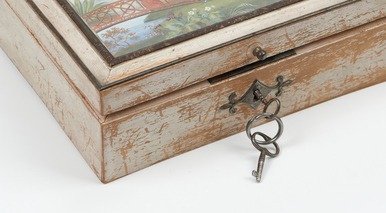The collection of the Yershov Museum Complex of Ishim City houses a bouillotte — a small teapot with a water heater for a long tea party.
In the 18th century, samovars (‘self-brewer’ in Russian) were used to boil and brew tea in Russia, however, due to their large size, they could only be used in a house or the backyard. At the end of the 19th century, the bouillottes were introduced, they were similar to samovars in their structure but smaller in size. Historians found the origin of this vessel’s name — the English verb “to boil” and the equivalent verb “bouillir” in French, their translation into Russian are the same — “to boil”.
The bouillotte consisted of the vessel with a lid, one or two small taps in the bottom, and the stand for the spirit lamp. A handle, attached to the top, was used for easy transportation of the vessel. In Western Europe and Russia, bouillottes, due to their compactness and convenience, became an integral part of travelers’ luggage. The main advantage of these vessels was not only their lightweight, but a simple way to maintain the temperature as well. In the samovar, it was necessary to rekindle the fire, and in the bouillotte, the water was usually heated by a spirit lamp installed in its lower part. However, it was also possible to come across vessels that had a narrow inner tube with a ‘weight’ — a red-hot metal rod — inside the tube.
Most commonly, the bouillottes were used to maintain the temperature of the water, and not to boil it. Most often, water was firstly boiled in the samovar, and then the boiled water was collected in the bouillotte and served on the table.
In Russia, such vessels were manufactured in Moscow, St. Petersburg, and Tula. In Europe, there were bouillottes of English and Danish production. In aristocratic houses, one could see these vessels made of silver. The families from more humble beginnings acquired bouillottes made of cupronickel, brass, or copper-silver alloy.
There were both simple and decorated vessels on the market. Expensive bouillottes were decorated with engraving, embossing, or painting. The shape of such a ‘teapot’ was also quite different — from cylindrical and conical to sophisticated, in the form of animals.
The bouillottes were used not only for tea but also for brewing coffee, boiling eggs, preparing mulled wine, punch and grog. The exhibit entered the museum collection in 2005, it was a donation from Vladimir Simonenkov.
In the 18th century, samovars (‘self-brewer’ in Russian) were used to boil and brew tea in Russia, however, due to their large size, they could only be used in a house or the backyard. At the end of the 19th century, the bouillottes were introduced, they were similar to samovars in their structure but smaller in size. Historians found the origin of this vessel’s name — the English verb “to boil” and the equivalent verb “bouillir” in French, their translation into Russian are the same — “to boil”.
The bouillotte consisted of the vessel with a lid, one or two small taps in the bottom, and the stand for the spirit lamp. A handle, attached to the top, was used for easy transportation of the vessel. In Western Europe and Russia, bouillottes, due to their compactness and convenience, became an integral part of travelers’ luggage. The main advantage of these vessels was not only their lightweight, but a simple way to maintain the temperature as well. In the samovar, it was necessary to rekindle the fire, and in the bouillotte, the water was usually heated by a spirit lamp installed in its lower part. However, it was also possible to come across vessels that had a narrow inner tube with a ‘weight’ — a red-hot metal rod — inside the tube.
Most commonly, the bouillottes were used to maintain the temperature of the water, and not to boil it. Most often, water was firstly boiled in the samovar, and then the boiled water was collected in the bouillotte and served on the table.
In Russia, such vessels were manufactured in Moscow, St. Petersburg, and Tula. In Europe, there were bouillottes of English and Danish production. In aristocratic houses, one could see these vessels made of silver. The families from more humble beginnings acquired bouillottes made of cupronickel, brass, or copper-silver alloy.
There were both simple and decorated vessels on the market. Expensive bouillottes were decorated with engraving, embossing, or painting. The shape of such a ‘teapot’ was also quite different — from cylindrical and conical to sophisticated, in the form of animals.
The bouillottes were used not only for tea but also for brewing coffee, boiling eggs, preparing mulled wine, punch and grog. The exhibit entered the museum collection in 2005, it was a donation from Vladimir Simonenkov.



